In Greek there are the word "footnotes" that translates to "Cruz".In this word, doctors point out the curve of the spinal column.Moreover, not all curves, in particular, the lateral deviation of the vertical axis of the spine.The fact is that our spine is usually not perfect.The front and back curves (lordoses and kyphosis) protect our spine from excessive loads, while maintaining the body in a certain state when moving and weight.Negative processes in our body develop only in cases where these kyphosis and lords are manifested in excessive amounts of permissible norm.
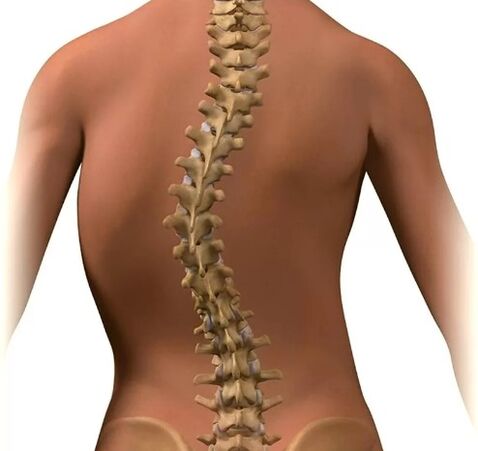
The main problems
However, even a small degree of spine side curves (scoliosis) is always a pathology.And the point is not only with a cosmetic defect.Despite the characteristic reprimand appearance with pronounced or progressive scoliosis is always a tragedy for a person who seeks a high quality life.This is especially true for young boys and girls.Indeed, a significant portion of scoliosis is diagnosed in children and youth (15 - 16 years).
The main problem is that due to the changes in the chest configuration and volume changes, a pronounced lateral curve, internal organs are always affected (heart, lungs, stomach, liver, intestines, large vessels).In men, tolerance for physical exercise is reduced, women have problems with conception, pregnancy and childbirth.Moreover, the lateral deformation of the spine is only a superficial part of the iceberg, which is a sign of much more serious pathology - tumor, tuberculosis, endocrine disorders.
Causes
Why is the spine deformed?Before answering the question, you need to decide the types of scoliosis.Its core, scoliosis can be structural and unconstructive.Structural scoliosis develops due to anatomical changes in the structure of the bone tissue of the spine, as well as due to muscles, nerves, and ligaments nearby.The purchase of such curves can be congenital, and about a quarter of diagnosed scoliosis is the latter.
Among the main causes of the development of structural scoliosis, they distinguish:
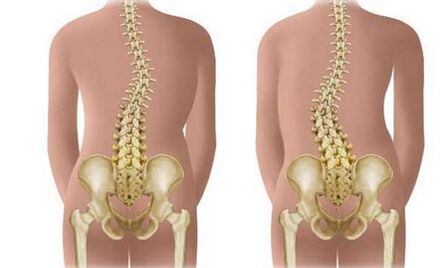
- Intrauterial development masts that cause one or more spine dysplastic disorders
- Chest Congenital Development Pathologies - Lack of Ribs, Additional Ribs
- Congenital pathology of connective tissue - neurofibromatosis, Marfan syndrome
- Brain failure due to cerebral paralysis of children (cerebral palsy), causing disruption of the innervation of certain parts of the spine
- Osteoporosis of the spine
- Osteomyelitis of the spine
- Dystrophic changes in the cervix, chest and lumbar muscles
- Tuberculosis damage to the spine
- Spinal injuries
- Spine tumors.
Non -structural scoliosis seems to be from this name, the lateral deviation of the spinal column axis with an unchanged structure of the spine.Typically, such scoliosis is most often acquired except when the curve is compensated for in nature, with congenital anatomical defects in the pelvis or lower extremities.The causes of such scoliosis are most often:
- Pelvic injuries and lower extremities
- Congenital defects of the pelvis and lower extremities
- Permanent inappropriate posture in school students
- Diseases of the internal organs with asymmetrically pronounced pain syndrome
- Inflammation of the muscles (myosites)
- Burn, soft tissue scars on one side.
In these cases, it is sufficient to cure the underlying disease and therefore many non -constructive scoliosis are easily reversible.In this sense, some physicians generally do not include non -instructural deformations for scoliosis.
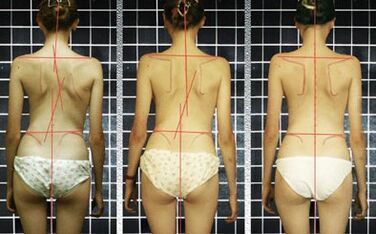
Recently, cases of scoliosis are more common for unknown reasons.This is the so -called idiopathic scoliosis.It is found in the youth years, during the rapid growth of the body.Moreover, girls experience idiopathic scoliosis several times more often than young people.It seems to be due to the weak muscles of the woman's posterior muscles that cannot be locked in the spine in the full frame of the muscles.Balanced diet for low calcium salts and young people with carbonated drinks does not play a last role in the development of idiopathic scoliosis.As you know, carbon dioxide in blisters and orthophosphoric acid helps to impregnate calcium salts from the body.
Varieties and quality
Depending on the localization, scoliosis can be cervical, chest, waist or mixed (cervical, rain).It is possible to have one or more curved arcs.In this regard, C-shaped scoliosis (with 1 arc), S-shaped (2 arcs) and Z-shaped (3 arcs) are distinguished.The presence of 2 or 3 arcs is likely to be compensatory.With the scoliosis C, the axis of the spinal column.In an attempt to compensate for this, increase the spine in the opposite direction.In this sense, scoliosis is divided into paid and incompensating.Compensated spinal curve, the vertical line of the 7th cervical spine passes between the buttocks.
The spine curve is often united.For example, in the chest region, in addition to the lateral curve, abnormal kyphosis is noted, or simply crushed.In these cases, when talking about chest cyphosicolosis.In addition, with a large degree of scoliosis, in addition to the lateral movement of the spine, it is noted tour.In direct translation, it means deviation.Indeed, with many scoliosis, the spine bone tissue is turned along the vertical axis.
Depending on the angle of the curve, 4 degrees of scoliosis is distinguished:
- 1 degree- The angle of the curve does not exceed 10 degrees.Asymmetry is virtually not defined by the eye.The stoop, the uneven level of the shoulder girdle, pays attention.
- 2 degrees- The angle of the curve is 11 to 25 degrees.In this size, the vertebrates are already marked.There is an asymmetry of the shoulder girdle and pelvis, which is visible in the eyes.Due to the abnormal muscle tension, the muscle roller is formed from the lumbar region, and the chest is lubricated.
- 3 degrees- Wrtification is from 26 to 50 degrees.Chest Deficiency Deformation - Intercastal Spaces in the West C bend and convex.Weakening of the abdominal press, formation of internal horn.
- 4 degrees- The angle of the curve exceeds 50 degrees.Cosmetic defects and all previous signs are expressed.Even a little physical effort of small tolerance.In addition to the musculoskeletal system, internal organs are affected.
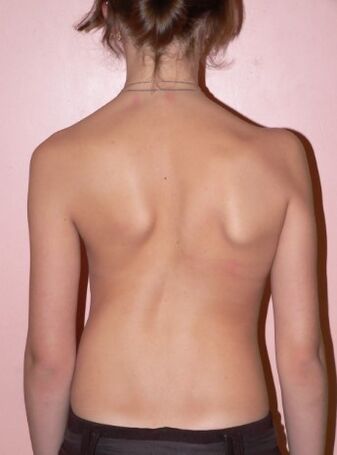
The angle may vary depending on the position of the body, and stable and unstable scoliosis is distinguished.With unstable scoliosis, it decreases in a lie when the load on the spinal column is reduced.With a stable curve of the spine, this meaning remains unchanged.
Symptoms
Recently, orthopedists have often used the term "scoliotic disease".They indicate a complex of negative changes that occur in the body during the spine curve.Usually, a scoliotic disease develops in childhood and adolescence, during the formation of the musculoskeletal system.At this time, there is a high likelihood that scoliosis progresses.
It seems that intervertebral drives play an important role in increasing the angle of the curve.With lateral movement, the disc suffers from uneven pressure from the spine organs.On the sloping side, this pressure is greater, with a convex - less.As a result, the disc carries more from scoliosis, abnormal muscle tension (muscle roller) and spine torso - all of which leads to the appearance of disk hernia and further growth of the rabbit.
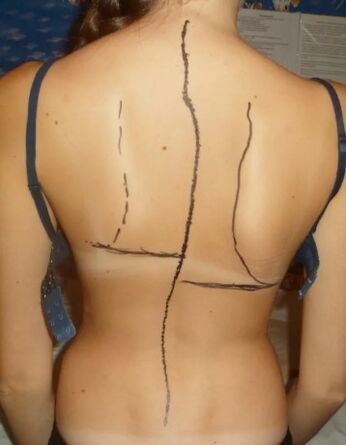
With a spine with a scoliotic disease, the chest changes the second time.The so -called rib crust is formed - the intercostal spaces are expanded on the curved side, and they are sown on the contrary.With a degree of scoliosis 4, the chest deformity is so pronounced that the lower ribs on the side of the curve are in contact with the Ilyak bone shovel.
Due to severe chest deformity, a full -fledged excursion during breathing is difficult.As a result, the body with severe scoliosis does not get the required amount of oxygen - the so -called chronic hypoxia develops in the body with all metabolic processes.The pathology is exacerbated by the fact that the internal volume and shape of the chest changes.Because of this, vessels disrupt blood circulation, the lungs are affected, the heart is changed, chronic cardiovascular failure develops.
Similar changes occur in the abdominal organs for lumbar and lumbar scoliosis.The gastric and intestinal highway is reduced by subsequent enzymatic insufficiency of the digestive glands.All this only exacerbates metabolic disorders.These disorders often cause the late sexual maturity of boys and girls.In addition, due to lumbar scoliosis, the pelvis is the second time.This creates problems for future mothers with gestation and childbirth.
Diagnostics
Diagnosis of scoliosis, especially high quality, is usually not difficult.Visual examination is often sufficient to detect the deformation of the spine.A prominent curve of the spine contours, shoulder girdle asymmetry, shoulder corners, pelvic secondary curve and lower limb reductions.
In the presence of at least one of these marks, radiography of the spinal column is indicated.X -Ray determines curve configuration, quality and localization.During examination and radiological examination, it can be determined whether scoliosis is compensated and stable.A qualitatively new method of research on the vertebral-magnetic resonance imaging (MRI) has recently been circulated, in which a three-dimensional image of the spine can be obtained on the monitor screen.With significant curves, it is necessary to investigate the work of the internal organs - to carry out spirometry, electrocardiography, and to perform ultrasound of the heart and internal organs.
Treat
Scoliosis can be treated both conservatively and immediately.Conservative methods include drug treatment, massage, physiotherapeutic procedures and manual therapy.It should be borne in mind that the final formation of the spine ends at the age of 20, and after this age, it is almost impossible to adjust the curve.With 1-2 degrees scoliosis, the effort is aimed at achieving the initial, normal configuration of the spine.With pronounced scoliosis 3 -4, this is unavailable, the main thing here is to stabilize the spine and prevent the progression of scoliosis.

Medications (chondroprotectors, vitamins, general amplifiers) play only auxiliary role in the treatment of scoliosis.To strengthen the muscles, eliminate muscle attraction and largely, with the help of massage and hand therapy, stabilize the spine.A good effect is given with physiotherapy exercises.But here, with inadequate physical effort, spine instability is improved and scoliosis develops.Thus, the combination of exercises for each patient develops individually, taking into account localization and gravity.External games are contraindicated with great degree of scoliosis, running, forces, jumps, outdoor games.
A very good result gives the position adjustment - an optimal posture is created that helps to normalize posture.Special devices, orthopedic peppers, young patients spend a significant amount of time.Ineffective conservative measures, progression of curve, surgical treatment aimed at stabilizing the spine.Surgical adjustments are not shown in early childhood, it is performed in adolescence when the spine is almost complete.

















































